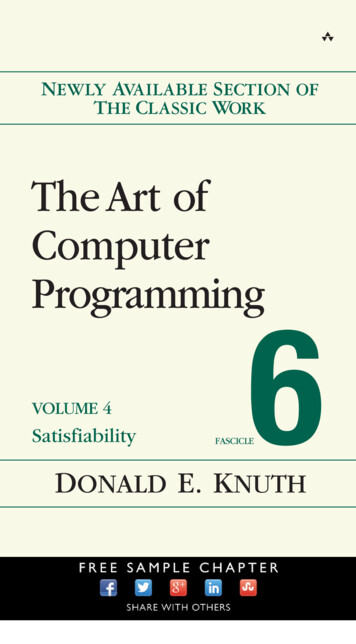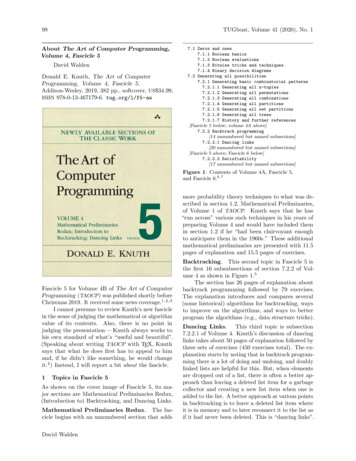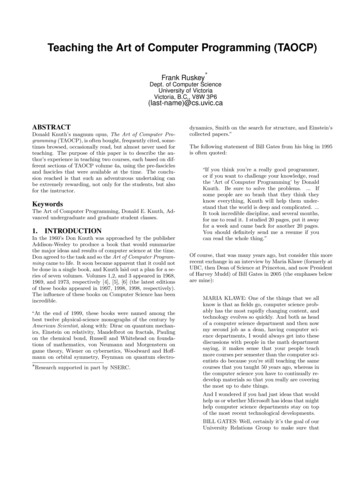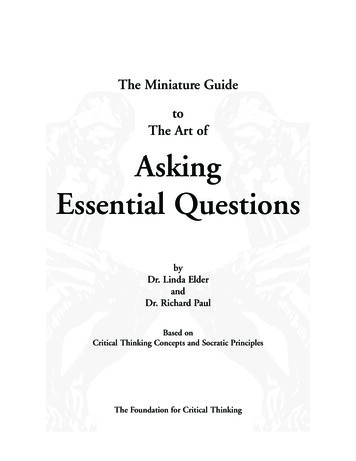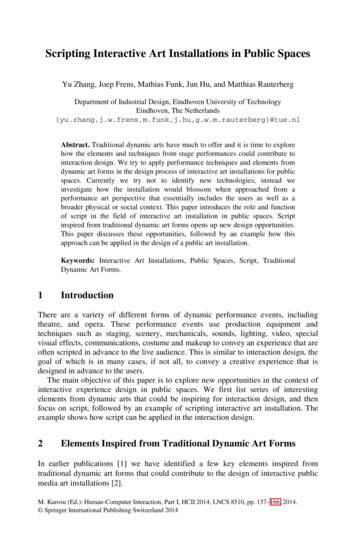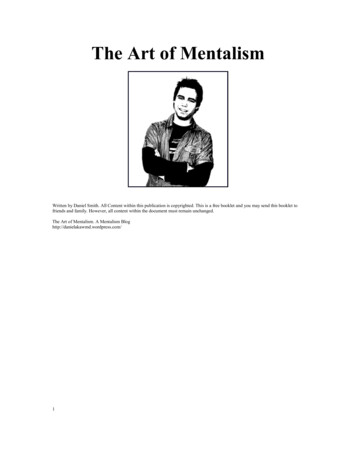
Transcription
The Art of MentalismWritten by Daniel Smith. All Content within this publication is copyrighted. This is a free booklet and you may send this booklet tofriends and family. However, all content within the document must remain unchanged.The Art of Mentalism. A Mentalism Bloghttp://danielakawmd.wordpress.com/1
ContentsIntroduction - Page 3-4What is Mentalism? - Page 5Improving Your Sense of Observation – Page 6Micro-expressions – Page 7-11Mirroring – Page 12-13Body Language – Page 14-19 Negative & Positive Body Language – 14-15 Confident Body Language – 12-13 Gesture Slip – 15-16 Common Signs of Doubt 17-18 Conversation Tips – Are they interested? 18-19Introduction to Cold Reading – Page 20 Cold Reading Techniques – 21-22 Cold Reading – Putting it into Action -22-23 Cold Reading – Psychometry – 24-25Improving Your Own Body Language – Page 26-27Introduction to Hypnosis – Page 28 Deepening a Trance – 29-30 Covert Hypnosis – How it's Done – 30-31 Self Hypnosis – How It's Done – 32-33Introvert VS Extrovert – What Are They? Page 34Body Language Signals and What They Can Mean – Page 35-36Goodbye Message - 362
IntroductionThe aim of this booklet is to discuss what Mentalism is and the different aspects ofMentalism. I plan to discuss in detail exactly what Mentalism is and how it can help youimprove certain aspects within your day to day routine. I came to learning aboutMentalism when I watched the hit UK show The Mentalist. Since then, I've beenresearching Mentalism and learning new techniques and applying them to my dailyroutine. I began writing a blog http://danielakawmd.wordpress.com/ in September 2009so that I could re-cap the things that I had learnt, but now it's become fairly popular withmany people wanting to learn these new techniques.Within this booklet, I plan to discuss the following subjects;MirroringImproving ObservationMentalismCold ReadingBody LanguageLie DetectionMicro-expressionsAttraction SignsMentalism Mind TricksImproving Your Own Body LanguageNLPThe booklet has been written in a way that you can jump from section to section andlearn the parts you're more interested in, rather than having to read through a wholesection of the booklet, before finally getting to the part that interests you, booklets likethat are annoying, aren't they?Before writing this booklet, I searched the internet to gather more information andimprove my knowledge on certain subjects that before, may have been a little lacking sothat when I came to writing this, I'd be able to put as much information in as possible,therefore giving you a better chance of being able to learn what you've come here to learn,and indeed, apply them to your life. I'll try and keep what I write as simple as possible sothat it's fairly easy to read and understand, whilst at the same time giving the rightamount of information, techniques and tips to enable you to go away from this bookletand practice them in real life.I'm not saying that reading this booklet will instantly give you the “powers” that you'dlike, but what it will do, is give you the means to practice what you'll like to learn and intern, become better at it.
3Practice makes perfect, I've done the work collecting the information and passing it ontoyou, it's now your turn to apply what is written in this booklet and practice to becomebetter.Whilst discussing each subject, there will be pictures to help break-up the text and todemonstrate what certain gestures, movements and facial expressions mean. I find thathaving a picture next to an explanation helps a great deal. So without further ado, andbefore I start rambling on too much, we'll move onto the first topic.
4What Is Mentalism?Mentalism is a subcategory form magic, but instead of pulling rabbits out of a hat anddoing cheap illusions. It revolves more around the Mental/Mind side of things, Mentalism,also known as “Mind Magic” uses observation, hypnosis and/or mental acuity tomanipulate someone's thoughts and behaviour. Mentalism can involve manipulatingpeople to believe an idea was theirs, when in reality, it was you who subliminally plantedthat thought or idea into their mind.Mentalism is perhaps the more impressive form of magic and indeed, growing because itmakes the Mentalist appear to be a mind reader, Psychic even, when performing certaintechniques and tricks. Mentalists often use hypnosis and subliminal messaging withintheir acts to enhance the effects, everyone likes to see someone being hypnotised andmade to do funny things, don't they?Derren Brown is perhaps one of the most famous Mentalists in modern times, manypeople cannot understand how he does some of the tricks he does, but when you learnhow they're done, most of them are surprisingly simple.Hypnosis is one very highly popular form of Mentalism. Psychiatrists actually regardhypnosis as an everyday activity or state that we undergo when we are watching movies,reading books, or driving down a long empty road. When we are doing these sorts ofactivities we enter a trance-like condition in which we are very vulnerable to the power ofsuggestion and feel extremely relaxed. Some people are mistakenly under the impressionthat hypnosis is like being asleep, but it's actually a hyper-aware, hyper-attentive state.It's also a state of total consciousness.Having a high sense of observation is also an important factor if you want to become aMentalist, being able to notice the small body movements, and fall facial twitches can bevery important when it comes to reading or Cold Reading a subject.When people see Mentalists, MANY come away thinking that they must be psychicbecause of the things they have been able to do, but in reality, they're just payingattention and using subliminal messaging and manipulation to plant thoughts into yourmind.
5Improving Your Sense ofObservationIn this article, I'm going to explain how you can improve your sense of observation.Having a heightened sense of observation not only improves your memory, but it alsohelps you see the small details that many people would miss, and this enables you to honein on things and become a more accurate reader of body language. Without looking, whatcolour is next doors gate? If you can answer, then you have a good sense of observation,if you can't, then you need to improve your observation. The good thing is, thatimproving your observation is a fairly easy thing to do, but it will requite somecommitment and practice to enable you to do so, but the rewards in the end will pay off.The best way for me, was to consciously look at things whilst I was walking down thestreet. Next time you're walking down your own road, look around you, try and noticesomething that you've never seen before, despite walking down that road hundreds oftimes. If you make a conscious effort to look around you for a few weeks, this willeventually become something that you subconsciously do, just like when you first learnedto ride a bike, you had to consciously balance yourself, but now, you do it without eventhinking about it.After a few days, you should test yourself. When you're out and about, look behind youfor a couple of seconds and then look back, in your mind make a note of what you saw,the colour of the car coming towards you, the colour shirt that guy was wearing acrossthe road, and then look back to see whether you were right or not, if you were,congratulations, keep it up. If you wasn't right, which you might not be the first couple oftimes, stick with it, it WILL come to you eventually.Improving your observation is not necessary, and you can still do the tricks andtechniques that have been discussed in this booklet, however having an improved senseof observation will help you become more accurate and better at what you do.
6Micro-expressionsMicro-expressions were first discovered by Haggard and Isaac's during a study back in1966, they discovered these “micromomentary” expressions whilst looking through hoursof psychotherapy videos. Micro-expressions are very brief lasting only a fraction of asecond and they often show the emotion that someone is trying to suppress.Psychologist Dr. Paul Ekman set out on a task to find out whether these facialexpressions were universal around the world and to do this, he found a very rural AfricanTribe, one that had, had no other human contact in their entire life, and what he foundwas astonishing. He found that despite them having no contact with other humans theyshowed emotion in exactly the same way that we civilization folk do. Paul Ekman thendecided to look into expressions through different cultures. At the end of his research hehad discovered that there are 7 universal expressions. These are; ch of these expressions appeared to be the same on everyone’s faces, despite theirculture and origin. Micro-expressions can be used to tell how a person is really feelinginside and it can also be used to see when someone is lying, for example if someone istrying to be happy about something, but keeps showing a micro-expression of disgust oranger.Paul Ekman discovered that out of the entire population, roughly 1% of people can spotmicro-expressions without any training at all, these people are called “naturals” or“wizards”. If you’ve ever watched the hit US show Lie To Me you’ll know that RiaTorres is one of these naturals.Spotting Micro-expressions is hard because of how quickly they flash on and off the facein less than a fraction of a second. The best advice I can give to spotting these is to lookclosely at someones face whilst they're talking. Micro-expressions cannot be faked sowhen you see one, it will be real. I’m just going to give a brief overview of eachexpression and what it looks like.Disgust7
Disgust is perhaps the easiest microexpression to see because it involves a large portion of the face. If you’re with agirlfriend/boyfriend and you see them showing disgust towards you then chances are thatrelationship is coming to an end. Disgust is a very strong emotion, perhaps one of thestrongest emotions you can have towards another person because its very likely to lastlonger than any other emotion you might have towards someone, such as anger. Ifsomeone shows a disgust expression whenever they talk about a certain thing, place, orperson then chances are they do not like to be around them and do not like them, ifthey’re talking in a nice way about them but keep showing a disgust expression, thenchances are they’re simply pretending.SurpriseSurprise isn’t something that we needto focus on too much when it comes to knowing how someone feels. However surprise isvery easy to fake, so if you confront someone about something and you see thisexpression for longer than one second then its fake, and they know exactly what you’retalking about but they want to appear for some unknown reason, that they’ve only justfound out.Surprise is often confused with fear. When the surprise expression is shown on the face,the eyebrows and eyelids go upwards causing wrinkling on the forehead, and the jawdrops causing an oval shape around the mouth.8
Fear is often confused with surprise because there are some similarities. Fear will showacross someones face if they become scared of getting found out, or perhaps they’re justgoing to an interview and they’re scared of how things will go, they might try to appearcalm and confident, but a quick fear expression would tell us that inside, they’re scared.When fear comes onto the face its fairly similar to surprise, but their are some verydistinct differences, the eyebrows go up and they’re pulled together which createswrinkling between them, the lower eyelids become tensed and the corners of the lipsstretch horizontally.AngerAnger has a fairly jagged onset andnever comes on suddenly. So if someone is sitting there nice and calmly and thensuddenly reacts in anger with fists raging, then chances are that anger is fake. Anger is anemotion that many people will try to hide until it gets to much and this is when anger mayappear on the face as a micro-expression. It may also appear when someone is talkingabout someone, and they’re trying to hide their anger for them.When anger appears on the face, the eyebrows are pulled down and together, the eyesbegin to glare and and red part of the lips begins to narrow because the lips are pressedtogether.9
ContemptContempt is the only Microexpression that appears on one side of the face, and usually appears around the corners ofthe lips. This expression is probably one of the more subtle expressions, but with a littlepractice fairly easy to spot. Contempt may occur just after someone has told a lie, orsomeone of a higher authority of you may show contempt when having a go at you, orsimply giving you orders.When contempt appears on the face it’ll appear on either the left or right side of the faceand around the lip corners. When someone shows contempt one lip corner will tightenand stretch out towards the ears, as shown in the picture of George Bush on the right. Hiscontempt is showing on the right hand side of his face.8SadnessSadness will appear on someones face while, well, feeling sad inside. They may try tohide the sadness with a masking smile (we’ll talk more about masking smiles in futurearticles) so that people cannot see how they’re truly feeling. But the feeling of sadnesswill leak through in a micro-expression. Sadness for me, is one of the hardest Microexpressions to spot because it’s very subtle and fairly hard to spot. Remember Microexpressions happen in 1/5th of a second, so they happen very very fast.10
When sadness appears on the face, the corners of the lips are pulled down slightly tomake the lips appear a little pouted. Eyelids will droop and it’ll look like their eyes arelosing focus. The inner eyebrows will also be pulled upwards and together, causingwrinkling between them as seen on the picture to the left.HappinessHappiness is perhaps one of theeasiest to
The Art of Mentalism Written by Daniel Smith. All Content within this publication is copyrighted. This is a free booklet and you may send this booklet to




